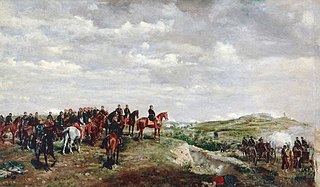Austro-Sardinian War
| Second Italian War of Independence | |||||||||
|---|---|---|---|---|---|---|---|---|---|
| Part of the wars of Italian Unification | |||||||||
 Napoleon III at the Battle of Solferino, by Jean-Louis-Ernest Meissonier Oil on canvas, 1863 |
|||||||||
|
|||||||||
| Belligerents | |||||||||
|
Supported by: |
|
||||||||
| Commanders and leaders | |||||||||
|
|
|
||||||||
| Strength | |||||||||
|
French: 170,000 infantry 2,000 cavalry 312 guns Sardinian: 70,000 infantry 4,000 cavalry 90 guns |
Austrian: 220,000 infantry 22,000 cavalry 824 guns |
||||||||
The Second Italian War of Independence, also called the Franco-Austrian War, Austro-Sardinian War or Italian War of 1859 (French: Campagne d'Italie), was fought by the Second French Empire and the Kingdom of Sardinia against the Austrian Empire in 1859 and played a crucial part in the process of Italian unification.
The Piedmontese, following their defeat by Austria in the First Italian War of Independence, recognised their need for allies. This led Camillo Benso, conte di Cavour, the prime minister of the Kingdom of Piedmont-Sardinia, to attempt to establish relations with other European powers, partially through Piedmont's participation in the Crimean War. In the peace conference at Paris following the Crimean War, Cavour attempted to bring attention to efforts for Italian unification. He found Britain and France to be sympathetic, but entirely unwilling to go against Austrian wishes, as any movement towards Italian independence would necessarily threaten Austria's territory Lombardy–Venetia. Private talks between Napoleon III and Cavour after the conference identified Napoleon as the most likely, albeit still uncommitted, candidate for aiding Italy.
On 14 January 1858, Felice Orsini, an Italian, led an attempt on Napoleon III's life. This assassination attempt brought widespread sympathy for the Italian unification effort, and had a profound effect on Napoleon himself, who now was determined to help Piedmont against Austria in order to defuse the wider revolutionary activities that the governments inside Italy might allow to happen in the future. After a covert meeting at Plombières, Napoleon III and Cavour signed a secret treaty of alliance against Austria: France would help Sardinia-Piedmont to fight against Austria if attacked, and Sardinia-Piedmont would then give Nice and Savoy to France in return. This secret alliance served both countries: it helped with the Sardinian (Piedmontese) plan of unification of the Italian peninsula under the House of Savoy, and weakened Austria, a fiery adversary of Napoleon III's French Empire.
...
Wikipedia
